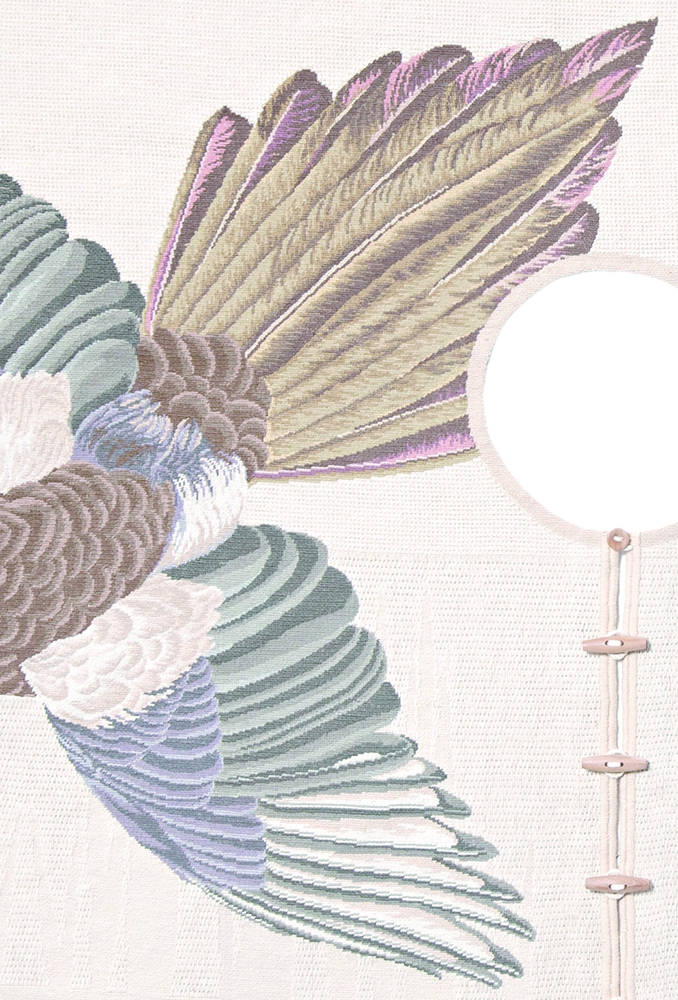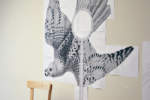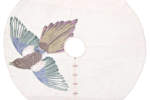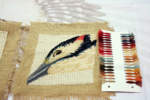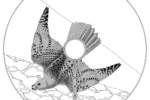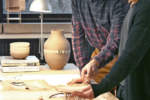architect: Formafantasma/Nodus Rug
location: The Netherlands, Italy
Formafantasma
area: Simone Farresin and Andrea Trimarchi, also known as “Formafantasma”. Where does the name come from?
Formafantasma: We are very fond of our name, Formafantasma, because we chose it even before opening a firm and moving to Holland, when our works were still more graphic and two-dimensional. The name refers to our conceptual approach; the form may change to adapt to the situation and content. If you think about our objects, you find that their forms are very often archetypes.
area: You have both studied at the Isia in Florence and then at the Design Academy in Eindhoven. What do you think about your studies? Who have been your “gurus”?
Formafantasma: Yes, we have both studied at ISIA and then at the Design Academy in Eindhoven. We applied to that school with a joint portfolio, and were accepted as a team. We decided to continue our studies outside Italy because we found the way Dutch designers of our generation work to be more similar to us and our way to explore design as a discipline. At Eindhoven we have studied our conceptual attitude in depth, and we have been able to explore themes that are not necessarily or directly linked to mass production more profoundly. We don’t have any gurus.
area: When you decided to “migrate” to Holland, why did you keep an Italian name?
Formafantasma: Why not?! Even if we use an Italian name we find it hard to define ourselves in nationalistic terms. We feel Italian and some of our works are directly referred to elements belonging to the Italian culture (as for instance the Moulding Tradition) but we wouldn’t be able to say in just what these influences consist.
As designers we have a profound respect for those Italian companies which have been able to demonstrate the value of design in the community and in production, as for instance Flos and, in the past, Olivetti.
area: What is it like to work together? How do you share your tasks?
Formafantasma: On a creative level we always work together, and it therefore hard for us to say how we share the tasks. On a bureaucratic level Andrea takes more care of sending mails and keeping contacts with suppliers, clients, journalists etc., while Simone tends to take more care of phone calls, interviews or conferences.
area: Your projects are always based on an in-depth study of the materials and the techniques, but they are above all inspired by other disciplines. What project of yours has required the greatest effort?
Formafantasma: Botanica, ordered by the Plart Foundation, called for a very time-consuming research. The work brings to light a number of vegetal-origin polymers used before the advent of oil. It has been risky but fascinating to dedicate a relatively long period to research materials that have practically disappeared.
area: On what studies are the “Migration” range of tapestries based?
Formafantasma: We have worked in various phases. First of all we sent our craftsmen a series of technical summaries with specific requests. For instance, to use different thicknesses of wool or very unusual stitches. We wanted to make sure that we could create surfaces that were interesting on a tactile level, that amplified the expressive potential of Portuguese needlepoint. Another fundamental part was our colour research. We were anything but satisfied by the first samples. The colours were in sharp contrast, with a ‘pixel’ effect. At this point of the project, very little time was left before the Milan Salon, and as we did not have time to produce other samples, we personally chose three colour charts (thirty colours per carpet) of woollen yarn. It was risky, but we were more than happy when we saw the results.
area: “Migration” is the result of a commission by Nodus, an Italian carpet manufacturer: do you prefer to work on commission, or to propose your projects to large companies?
Formafantasma: We have never proposed anything to any company or gallery. The collaboration is decidedly better if it is the company that contacts the designer.
area: How has your collaboration with Nodus gone?
Formafantasma: Great! Andrea Galimberti is a fantastic partner with a rare enthusiasm. Apart from being extremely professional, Andrea has the merit of truly believing in the work of designers. We couldn’t have asked for more.
area: What are you working on now, and for what brand?
Formafantasma: At the moment we have just finished a project presented at Design Miami/Basel with the Libby Sellers Gallery. In addition to a number of designs for galleries, we are beginning a project for a large Italian company. In any case, we cannot say anything more.
Nodus Rug
area: Nodus is part of the Il Piccolo company, for which it serves as an experimentation workshop: when was the idea of this project born?
Andrea Galimberti: I have always wanted to work with design, but I would never have thought of producing rugs. While decorating prestigious homes all over the world
I have noticed that there was an unsupplied need in the sector of high quality contemporary rugs; wonderful contemporary homes with antique Persian carpets and
no other option. In 2008 I thought of asking Italo Rota, with whom we cooperate in the creation of the Just Cavalli boutiques, almost playfully to ideate the first project, and it all started from there. A bulb lit up in my head, and I began to travel and study, choosing the best products in the world.
area: Nodus “weaves wool and silk, form and colours, past and future, East and West, crafts, art and design”: do you think it is possible to unite all these aspects in a rug?
Andrea Galimberti: Yes, definitely, and I have proven it. We have made carpets of every kind and make with traditional and innovative materials, we have allowed far-away populations participate on the same level as designers. In particular, in the case of Formafantasma we have given new life to an almost abandoned needlepoint technique of Portuguese origin. Andrea and Simone have not only reinterpreted it in the motifs; they have also added accessories made by hand in Italy, as buttons, and retraced their whole history using different kinds of embroidery. A perfect example of how Nodus intertwines design, colours, culture, art and design.
area: Nodus rugs are more similar to sculptures than to actual rugs: how important is quality to you, as compared to industrial production?
Andrea Galimberti: The quality and the ethical content of the product are constants from which we cannot depart. I am convinced that all the work and attention we dedicate to our realizations are appreciated by people. The recovery of tradition and manual know-how can only enrich the product.
area: Has the fact that you have involved famous designers been determined by a corporate marketing strategy from the start, or is it a recent evolution? Andrea Galimberti:
I would say that the collection itself answers that question. Ever since the first year we have presented internationally famous professionals, and the number has continued to grow in the second and third year.
area: Do you order products from your designers, or do you also work on suggestions you receive directly from them?
Andrea Galimberti: We intentionally do not put down any limits on the projects, we are not an industrial design firm. What we ask the designers is to express themselves as freely as possible, without any limits or almost; we want their interpretation of the contemporary rug.
area: How did the collaboration between your company and Formafantasma begin?
Andrea Galimberti: It began with mutual esteem. I sent an email and asked whether they might be interested in working with me, and they answered with enthusiasm and we have begun. Today I can say I am very happy that I have met them, they are two natural talents.
area: What designers have you worked with in the past, and who do you plan to work with after Formafantasma?
Andrea Galimberti: Many designers, young and not so young, famous and not so famous ones, chosen specifically because of their different educational backgrounds; I like to experiment and provoke also in this context. Next year we will commence new collaborations with designers as Aldo Bakker, Kiki Van Eijck, Jaime Hayon, Studio Job and others.
Andrea Trimarchi and Simone Farresin are Studio Formafantasma. The collaboration between the two started during their BA in communication design, illustrating books and magazines. Their interest in product design developed at the IM master course at Design Academy Eindhoven, where they graduated with a thesis based on traditional sicilian folk craft. The work of Studio Formafantasma touch relevant design issues such as the role of design in folk craft, the relationship between tradition and local culture, a critical approach to sustainability, and the significance of objects as a cultural vector.
Andrea and Simone believe in the role of the designer as a bridge between craftwork, industry, user and objects. From this inbetween position the studio is interested in creating a design practice that merges craft and industry, local necessity within the global context and on a conceptual level, to stimulate a more critical and conscious relationship of the user with objects. Works by Formafantasma are part of the collection of: Droog design, Rossana Orlandi gallery in Milan, Moss gallery Ny, Nodus rugs, Dilmos gallery and Libby Sellers gallery.
Nodus is a craft workshop with a cultural plan: the oldest traditions and knowledge in the art of carpet design are reinterpreted using the vision of the most innovating Designers and Architects, producing only unique pieces, promoting through events and publications in order to spread the knowledge to all about the new shapes and forms of a piece that has accompanied man since antiquity. Craftsmanship: Il Piccolo has selected from the best producers in six countries of the world (Nepal, Pakistan, India, Turkmenistan, China and Turkey), visiting them one by one, verifying materials, techniques, expert craftsmen and ethical production. Each carpet from Nodus will be a unique piece, entirely made by hand, including the packaging. Designers, Architects and Artists: even before beginning, Nodus had gathered the enthusiasm and support from some of the biggest Italian and foreign brand names.


